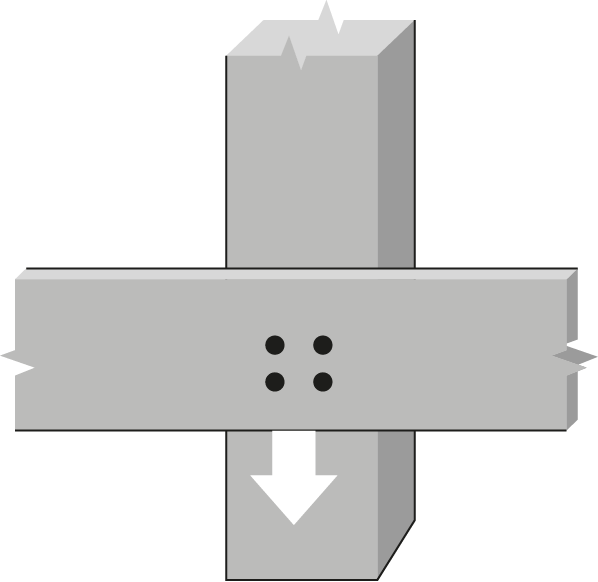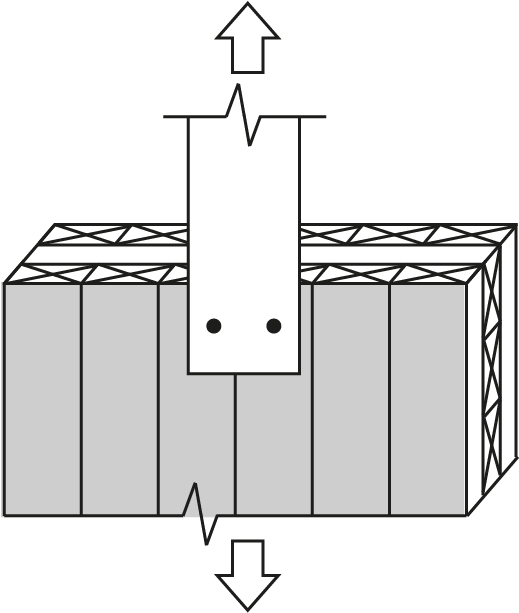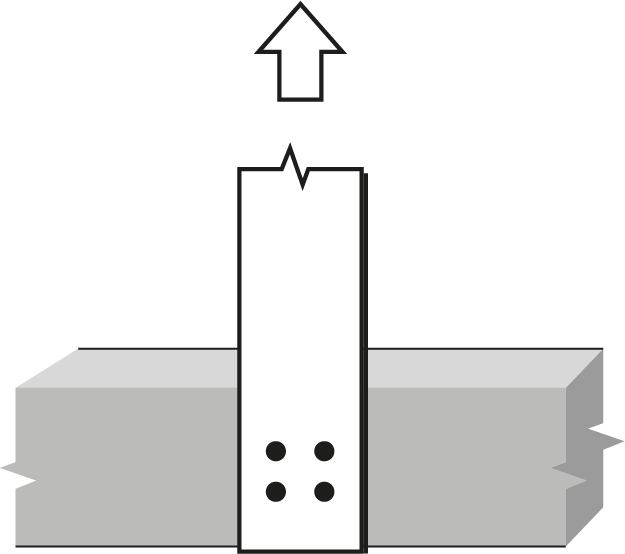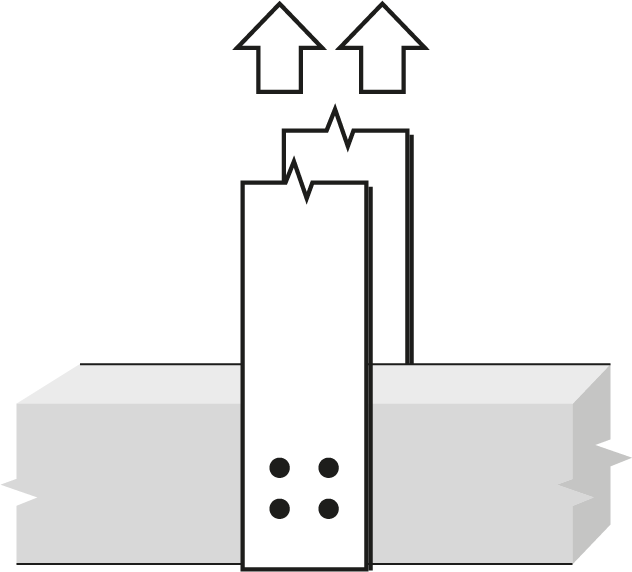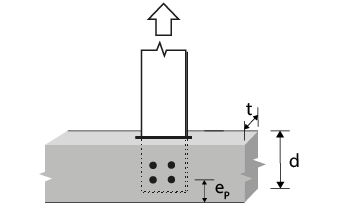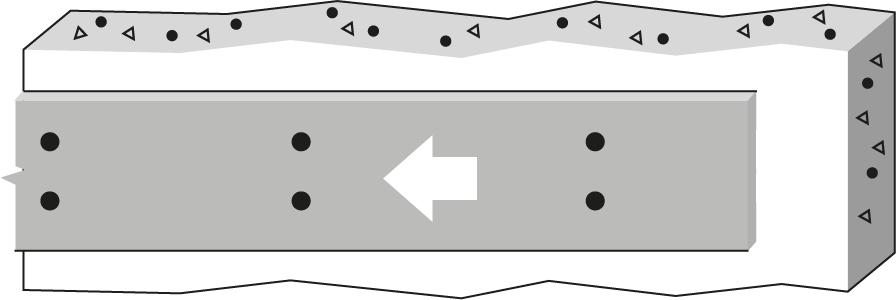 |
5/8″ Bolt or dowel Double Shear, Hem-Fir lumber to 6 mm steel plates |
 |
|||||||||||||
| Wood Member | Fastener |
 |
|||||||||||||
|
Thickness (mm) |
Depth (mm) |
No. of rows |
 |
No. of fasteners in a row | |||||||||||
| 2 | 3 | ||||||||||||||
| Bolt spacing in a row taken as the minimum of the loaded end distance3, aL, and the spacing between bolts in a row, SR (mm) | |||||||||||||||
| 64 | 95 | 127 | 159 | 190 | 64 | 95 | 127 | 159 | 190 | ||||||
| 38 | 89 | 1 | 0 | 6.49(R) | 9.73(R) | 13.0(R) | 16.2(R) | 18.7(c) | 9.73(R) | 14.6(R) | 19.5(R) | 22.6(T) | 22.6(T) | ||
| 38 | 184 | 2 | 47.625 | 11.4(G) | 14.6(G) | 17.9(G) | 21.1(G) | 24.4(G) | 14.6(G) | 19.5(G) | 24.4(G) | 29.2(G) | 34.1(G) | ||
| 38 | 184 | 2 | 79.375 | 13.0(R) | 19.5(R) | 23.1(G) | 26.4(G) | 29.6(G) | 19.5(R) | 24.7(G) | 29.6(G) | 34.5(G) | 37.7(T) | ||
| 38 | 235 | 2 | 111.125 | 13.0(R) | 19.5(R) | 25.9(R) | 31.6(G) | 34.8(G) | 19.5(R) | 29.2(R) | 34.8(G) | 39.7(G) | 44.6(G) | ||
| 38 | 235 | 3 | 47.625 | 16.3(G) | 19.5(G) | 22.8(G) | 26.0(G) | 29.3(G) | 19.5(G) | 24.4(G) | 29.3(G) | 34.1(G) | 39.0(G) | ||
| 38 | 235 | 3 | 62.5 | 19.5(R) | 24.4(G) | 27.7(G) | 30.9(G) | 34.2(G) | 24.4(G) | 29.3(G) | 34.2(G) | 39.0(G) | 42.3(T) | ||
| 89 | 89 | 1 | 0 | 15.2(R) | 22.8(R) | 30.4(R) | 38.0(R) | 43.7(c) | 22.8(R) | 34.2(R) | 45.6(R) | 53.0(T) | 53.0(T) | ||
| 89 | 184 | 2 | 47.625 | 26.7(G) | 34.3(G) | 41.9(G) | 49.5(G) | 57.1(G) | 34.3(G) | 45.7(G) | 57.1(G) | 68.5(G) | 79.9(G) | ||
| 89 | 184 | 2 | 79.375 | 30.4(R) | 45.6(R) | 54.1(G) | 61.7(G) | 69.3(G) | 45.6(R) | 57.9(G) | 69.3(G) | 80.7(G) | 88.3(T) | ||
| 89 | 235 | 2 | 111.125 | 30.4(R) | 45.6(R) | 60.8(R) | 74.0(G) | 81.6(G) | 45.6(R) | 68.4(R) | 81.6(G) | 93.0(G) | 104(G) | ||
| 89 | 235 | 3 | 47.625 | 38.2(G) | 45.8(G) | 53.4(G) | 61.0(G) | 68.6(G) | 45.8(G) | 57.2(G) | 68.6(G) | 79.9(G) | 91.3(G) | ||
| 89 | 235 | 3 | 62.5 | 45.6(R) | 57.3(G) | 64.9(G) | 72.5(G) | 80.0(G) | 57.3(G) | 68.7(G) | 80.0(G) | 91.4(G) | 99.1(T) | ||
| 140 | 140 | 1 | 0 | 17.9(R) | 26.9(R) | 35.8(R) | 44.8(R) | 50.6(g) | 26.9(R) | 40.3(R) | 53.8(R) | 56.0(T) | 56.0(T) | ||
| 140 | 191 | 2 | 47.625 | 26.1(G) | 35.0(G) | 44.0(G) | 53.0(G) | 61.9(G) | 35.0(G) | 48.5(G) | 61.9(G) | 65.7(T) | 65.7(T) | ||
| 140 | 191 | 2 | 79.375 | 34.8(G) | 43.8(G) | 52.7(G) | 61.7(G) | 65.7(T) | 43.8(G) | 57.2(G) | 65.7(T) | 65.7(T) | 65.7(T) | ||
| 140 | 241 | 2 | 111.125 | 35.8(R) | 53.8(R) | 71.7(R) | 89.6(R) | 101(g) | 53.8(R) | 80.7(R) | 108(R) | 125(G) | 138(G) | ||
| 140 | 241 | 3 | 47.625 | 53.8(R) | 63.6(G) | 72.6(G) | 81.5(G) | 90.5(G) | 63.6(G) | 77.1(G) | 90.5(G) | 104(G) | 117(G) | ||
| 140 | 241 | 3 | 62.5 | 53.8(R) | 80.7(R) | 90.9(G) | 99.9(G) | 109(G) | 80.7(R) | 95.4(G) | 109(G) | 122(G) | 136(G) | ||
| 191 | 140 | 1 | 0 | 24.5(R) | 36.7(R) | 48.9(R) | 50.6(g) | 50.6(g) | 36.7(R) | 55.0(R) | 70.5(T) | 70.5(T) | 70.5(T) | ||
| 191 | 191 | 2 | 47.625 | 35.6(G) | 47.8(G) | 60.0(G) | 72.3(G) | 84.5(G) | 47.8(G) | 66.2(G) | 84.5(G) | 89.7(T) | 89.7(T) | ||
| 191 | 191 | 2 | 79.375 | 47.5(G) | 59.7(G) | 71.9(G) | 84.2(G) | 89.7(T) | 59.7(G) | 78.0(G) | 89.7(T) | 89.7(T) | 89.7(T) | ||
| 191 | 241 | 2 | 111.125 | 48.9(R) | 71.6(G) | 83.8(G) | 96.0(G) | 101(g) | 71.6(G) | 89.9(G) | 108(G) | 109(T) | 109(T) | ||
| 191 | 241 | 3 | 47.625 | 46.7(G) | 59.0(G) | 71.2(G) | 83.4(G) | 95.6(G) | 59.0(G) | 77.3(G) | 95.6(G) | 99.2(T) | 99.2(T) | ||
| 191 | 241 | 3 | 62.5 | 57.9(G) | 70.1(G) | 82.3(G) | 94.5(G) | 99.2(T) | 70.1(G) | 88.4(G) | 99.2(T) | 99.2(T) | 99.2(T) | ||
| 241 | 140 | 1 | 0 | 30.9(R) | 46.3(R) | 50.6(g) | 50.6(g) | 50.6(g) | 46.3(R) | 69.4(R) | 75.9(g) | 75.9(g) | 75.9(g) | ||
| 241 | 191 | 2 | 47.625 | 44.9(G) | 60.3(G) | 75.8(G) | 91.2(G) | 101(g) | 60.3(G) | 83.5(G) | 104(T) | 104(T) | 104(T) | ||
| 241 | 191 | 2 | 79.375 | 59.9(G) | 75.3(G) | 90.8(G) | 101(g) | 101(g) | 75.3(G) | 98.5(G) | 104(T) | 104(T) | 104(T) | ||
| 241 | 241 | 2 | 111.125 | 61.7(R) | 90.3(G) | 101(g) | 101(g) | 101(g) | 90.3(G) | 113(G) | 137(G) | 137(T) | 137(T) | ||
| 241 | 241 | 3 | 47.625 | 59.0(G) | 74.4(G) | 89.8(G) | 105(G) | 121(G) | 74.4(G) | 97.5(G) | 121(G) | 125(T) | 125(T) | ||
| 241 | 241 | 3 | 62.5 | 73.0(G) | 88.4(G) | 104(G) | 119(G) | 125(T) | 88.4(G) | 112(G) | 125(T) | 125(T) | 125(T) | ||
| 292 | 140 | 1 | 0 | 37.4(R) | 50.6(g) | 50.6(g) | 50.6(g) | 50.6(g) | 56.1(R) | 75.9(g) | 75.9(g) | 75.9(g) | 75.9(g) | ||
| 292 | 191 | 2 | 47.625 | 74.8(R) | 94.4(G) | 101(g) | 101(g) | 101(g) | 94.4(G) | 122(G) | 150(G) | 152(g) | 152(g) | ||
| 292 | 191 | 2 | 79.375 | 74.8(R) | 101(g) | 101(g) | 101(g) | 101(g) | 112(R) | 152(g) | 152(g) | 152(g) | 152(g) | ||
| 292 | 241 | 2 | 111.125 | 74.8(R) | 101(g) | 101(g) | 101(g) | 101(g) | 109(G) | 137(G) | 151(T) | 151(T) | 151(T) | ||
| 292 | 241 | 3 | 47.625 | 71.4(G) | 90.1(G) | 109(G) | 128(G) | 138(T) | 90.1(G) | 118(G) | 138(T) | 138(T) | 138(T) | ||
| 292 | 241 | 3 | 62.5 | 88.5(G) | 107(G) | 126(G) | 138(T) | 138(T) | 107(G) | 135(G) | 138(T) | 138(T) | 138(T) | ||
|
Notes:
|
. | ||||||||||||||


